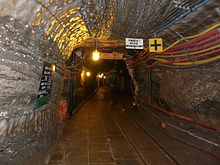Kopalnia Soli w Bochni

The Bochnia salt mine (in Polish kopalnia soli w Bochni ) in the southern Polish city of Bochnia ( German salt mine ) is one of the oldest salt mines in the world. Since 2013 it forms with the 25 km away Salzgrafenplatz castle and the salt mine in Wieliczka , the UNESCO - World Heritage Site Royal salt mines of Wieliczka and Bochnia . Both mines illustrate the development of mining techniques in Europe from the 13th to the 20th century. From 1248 until it was closed in the 1990s, salt was mined in Bochnia .
geology
See → Geology of the UNESCO World Heritage Royal Salt Mines Wieliczka and Bochnia
history
From the 14th century to 1772 the Wieliczka and Bochnia salt mines were united as Żupy krakowskie, the Royal Krakow Salt Pans , and were the largest mining company in Poland.
On April 22, 1368, Casimir the Great issued a mountain code that regulated salt production and trade . The administration of the salt pans was incumbent on a Żupnik , who had his seat in the Wieliczka Castle (Zamek Żupny). The income from the salt trade, which generated a third of the state's income during its heyday from the 14th to the 16th century, was used to cover the costs of building the royal Wawel Castle , the university and the city fortifications in Krakow, as well as the military pay .
From 1515 to 1523 was Hans Boner Żupnik, who also reformed the financial system in Poland. The company experienced its heyday in the 16th century until the middle of the 17th century. At that time there were 2,000 miners working in the mine and production exceeded 30,000 tons of salt. The salt was loaded onto ships on the Vistula , but also delivered to Ruthenia and Hungary .
The August sole as the most important connection and transport route of the mine was built in the years 1723–1743 according to a design by Johann Gottfried Borlach . In the next decades it was nearly 3 km extended . Borlach was an electoral Saxon mountain ridge at the time of August the Strong . His great achievement was to ensure the straightening and leveling of the mine.
A chapel was laid out in 1747, until 1782 it was called Nowa Kaplica Świętych Aniołów Stróżów (New Chapel of the Holy Guardian Angel), today it is dedicated to St. Kunigunde as the Kinga Chapel . With the first Polish partition (1772), the Cracow saltworks fell to the House of Austria and the Wieliczka and Bochnia mines were separated.
20th century
After 1918 the mine became state property of the Republic of Poland, which in 1932 reserved the state monopoly on salt. From 1968 to 1988 the salt was extracted by brining with water. In Łężkowice , 16.5 million m³ of salt solution were pumped out, from which 5 million tons of salt were extracted in Bochnia. The subsequent backfilling and recultivation took another 20 years.
UNESCO world heritage
In September 2000 the salt mine became a monument to the history of the Polish nation . In 2013, UNESCO added the salt mine in Bochnia to the Wieliczka World Heritage.
Plant and use
The oldest shafts are Sutoris and Gazaris, the Regis, Bochneris and Campi shafts were built by the 16th century. They lead over 16 levels to a depth of 330 to 468 meters.
The Ważyn Chamber lies at a depth of 248 meters, it is 255 meters long and was expanded to 14.4 meters wide and 7.2 meters high by 1984. At that time it was used as a healing gallery for the treatment of respiratory diseases . Today it is used for tourism and offers 252 places to stay, restaurants, disco, sports and playground, as well as conference rooms. A tourist route runs through the mine.
literature
- Łukasz Walczy: The Cracow salt pans Wieliczka and Bochnia in the initial period of the Austrian administration, (1772-1809). Verlag für Geschichte und Politik, 2001. 201 pages.
- Krzysztof Zięba: Urządzenia transportowe w Kopalni Soli Bochnia. In: Dzieje górnictwa - element europejskiego dziedzictwa kultury. 35 (3) 2009. Volume 2. pp. 368-379. (PDF, Polish)
- Johann Nepomuk Hrdina: History of the Wieliczka Saltworks . Vienna 1842. ( Digitized, also concerning Bochnia. )
Web links
Individual evidence
- ↑ Katarzyna Poborska-Młynarska: Techniki eksploatacji ługowniczej w złożu solnym Łężkowic - z historii produkcji solanki na Podkarpaciu. In: Geologia 35 (3) 2009. p. 394 (PDF, Polish with English summary)
- ↑ Kurt Schlünkes: natural paradises and cultural treasures of mankind. The 19 new UNESCO World Heritage Sites. Retrieved July 22, 2013 .
Coordinates: 49 ° 58 ′ 9 ″ N , 20 ° 25 ′ 3 ″ E



